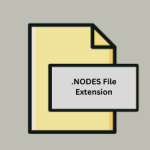.MIDI File Extension

MIDI Music Data
| Developer | N/A |
| Popularity | |
| Category | Audio Files |
| Format | .MIDI |
| Cross Platform | Update Soon |
What is an MIDI file?
.MIDI file extension is associated with the Musical Instrument Digital Interface (MIDI), a technical standard that describes a protocol, digital interface, and connectors.
This standard allows a wide variety of electronic musical instruments, computers, and other related devices to connect and communicate with each other.
A MIDI file, notably, does not contain actual audio data, but rather contains instructions that tell a musical instrument or software how to generate the audio, including notes, pitch, velocity, and control signals for parameters such as volume, vibrato, panning, and more.
More Information.
MIDI was conceived as a means of allowing electronic instruments to communicate with each other. Before MIDI, each manufacturer had its proprietary interface, which made compatibility between different brands almost impossible.
The introduction of MIDI revolutionized the music industry, allowing musicians and producers to use instruments and music production equipment from different manufacturers seamlessly.
It also paved the way for the development of digital audio workstations (DAWs) and software synthesizers, significantly impacting the production of music.
Origin Of This File.
The MIDI standard was developed in the early 1980s by a coalition of musical instrument manufacturers, including Roland, Yamaha, Korg, and others, to facilitate communication between different musical instruments and computers.
The first MIDI standard was published in August 1983, and the first public demonstration of a MIDI connection between two synthesizers took place in the same year.
File Structure Technical Specification.
.MIDI file is structured as a sequence of events, with each event representing a musical note or control signal. The file is divided into tracks, and each track contains a series of events.
The events are time-stamped, ensuring they play back in the correct order and at the correct time. .MIDI files support up to 16 channels, with each channel typically representing a different instrument.
The technical specifications of MIDI include:
- Standard MIDI File (SMF): This format is used to exchange music between different software applications and hardware devices.
- Channels: MIDI supports 16 channels per port. Each channel can represent a different instrument.
- Messages: MIDI messages are the instructions that are sent and received, containing information about notes, pitch, velocity, and other control signals.
How to Convert the File?
Converting .MIDI files to other audio formats like MP3 or WAV is a common task, especially when you want to share or listen to your music on different devices. Here’s how to do it:
Using Software Synthesizers (DAWs)
- Choose a Digital Audio Workstation (DAW): Install a DAW software like FL Studio, Ableton Live, or Reaper on your computer. Many DAWs offer a trial version if you don’t have one already.
- Import the .MIDI File: Open your chosen DAW and create a new project. Then, import the .MIDI file into your project.
- Select Instruments: In the DAW, you can choose virtual instruments or synthesizers to interpret the .MIDI data. This step allows you to select the sounds you want for each track.
- Render or Export: After selecting the instruments and configuring your project, you can render or export the project as an audio file. Choose the desired audio format (e.g., MP3 or WAV) during export.
Online MIDI to Audio Converters
- Search for Online Converters: There are several online MIDI-to-audio converters available. Use your web browser to search for one, such as “MIDI to MP3 converter.”
- Upload the .MIDI File: Most online converters have a simple interface. Upload your .MIDI file to the converter’s website.
- Configure Settings: Some converters allow you to configure settings like instrument selection and output quality.
- Convert and Download: Click the “Convert” button, and the converter will process your .MIDI file and provide a link to download the converted audio file.
Advantages And Disadvantages.
Advantages:
- Compatibility: One of the most significant advantages of MIDI is its compatibility with a wide range of instruments and computer systems.
- Flexibility: MIDI files are incredibly flexible. Users can modify the notes, swap instruments, and adjust the tempo without altering the underlying musical performance.
- Efficiency: MIDI files are small in size, making them easy to store and transfer, unlike audio files which can be large.
Disadvantages:
- Sound Quality: The sound quality of a MIDI file depends on the synthesizer or software used to play it. As MIDI only contains the performance data, not the actual audio, the quality can vary greatly.
- Complexity for Beginners: Understanding and editing MIDI files can be complex for beginners, as it requires knowledge of musical notation and sequencing.
How to Open MIDI?
Open In Windows
- Windows Media Player: Double-click the .MIDI file, and it should open in Windows Media Player by default. You can also use other media players like VLC.
- Digital Audio Workstations (DAWs): Install a DAW like FL Studio, Ableton Live, or Cakewalk to open and edit .MIDI files.
Open In Linux
- Rosegarden: Rosegarden is a powerful DAW for Linux that can open and edit .MIDI files. Install it using your distribution’s package manager.
- Qtractor: Qtractor is another DAW option for Linux users, available for installation via package manager.
Open In MAC
- GarageBand: GarageBand is a versatile DAW that comes pre-installed on macOS. It can open .MIDI files, and you can edit and export them.
- Logic Pro X: If you require more advanced features, Logic Pro X is a professional-grade DAW for Mac that also supports .MIDI files.
Open In Android
- MIDI Player Apps: Install a MIDI player app from the Google Play Store, such as MIDI Voyager or MIDI Player. These apps allow you to play .MIDI files on your Android device.
Open In IOS
- GarageBand: GarageBand is available on iOS devices as well. You can open, edit, and play .MIDI files on your iPhone or iPad using GarageBand.
- Other MIDI Player Apps: There are third-party MIDI player apps like Sweet MIDI Player available on the App Store for iOS users.













